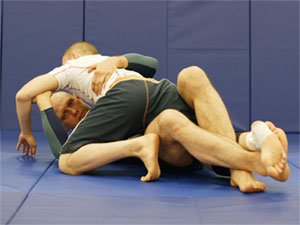Think about that question for a moment because there is room for debate. Right this minute, you can look around and you’ll find many different examples of how the position should be played. Like with almost everything in Jiu-jitsu, half guard is an expression of a person’s own unique insight and focus. So often there are variances in the technique or different concepts that are focused on.
One example I saw recently was a hour and half long instructional on Youtube. It focused on the importance of preventing the crossface, and the method for doing that was bear paw grips on the bicep of the opponent’s far arm. Almost all of the techniques and concepts focused on either preventing the crossface or using it to pass on top.
That’s where the emphasis was placed.
Now how my own half guard has developed has been totally different. I’ve never emphasized preventing the crossface because my prevention naturally happens as a result of how I attack from the position. The question is what concepts are really essential in order to effectively develop the position.
What I Saw
Let’s go back to the Functional Half Guard instructional by Indrek Reiland and Jorgen Matsi.
We’ve already discussed the emphasis that was placed on the crossface, but there was also a lack of emphasis directed towards the underhook. When you look at the video, you’ll notice that there are many times when the underhook demonstrated is quite shallow. That’s a hole that can be exploited.
Also in the demonstrations about how the bear paw can be used, his back hit the mat several times or he gave up the underhook in order to go double paw grip. To me, that’s fundamental concepts being broken, but that’s only because my perspective is different.
I value the underhook over the crossface.
What I Think The True Basics Are
At a basic level, there is one of two ways to attack from half guard. Either you dive deep and get under your opponent’s base then attack from there, or you dominate one side of their body and then initiate your offense.
That’s the goal, but there’s also a general to-do checklist.
- Fight to get to your side and stay there.
- Always fight for the underhook.
- Off balance your opponent whenever possible and don’t let them settle.
All of those are things to keep in mind while you’re playing that underhook half game. Now I’m going to explain some alternative ways to prevent the crossface that aligns with those that checklist.
First of all, in order to be effectively crossfaced, a condition has to be met. Your back or your shoulder has to be on the mat. So if you use the elbow or hand of your free arm to post, it’ll make it easier for you to stay on your side and harder for you to be crossfaced. It’s also easier to shoot the underhook deep and use it to off balance your opponent. To be crossfaced, that post will have to be pulled out from under you first, and you can prevent that by hiding the elbow under you.
Secondly, how you control the underhook matters. Where you place your hand on their hand, what you grab, whether pull or push, all of those things matter. The underhook is an active tool. Use it to upset your opponent’s base and leverage. It makes it harder for them to effectively crossface if you push their upper away from you or force their torso to rotate.
The Point of All This
The intent wasn’t to criticize someone’s perspective on how the half guard functions. Instead, I wanted to give you a clear example of how methods can change while the goal remains the same.

